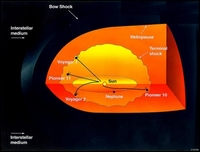High-speed plasma jets: origin uncovered
23 April 2010
For more than a decade, mysterious, high-speed plasma jets have been observed in space, downstream of the Earth's bow shock. The underlying formation mechanism for these jets has now been unveiled, thanks to data collected by the four ESA Cluster satellites. This study also suggests that such mechanisms may be relevant to other astrophysical shocks. |
| Image 1 Orbit of the Cluster satellites on 17 March 2007. Credit: ESA |
In the summer of 2000 the four Cluster satellites embarked on the first three-dimensional mapping of the Earth's magnetosphere. During the second extension of the mission (2005-2009), Cluster explored regions of the magnetosphere not originally targeted, thanks to the natural evolution of their nominal polar orbit.
On 17 March 2007, the four satellites were travelling along an orbit that crossed the magnetospheric region closest to the Sun, known as the subsolar magnetopause. Shortly after 17:00 UT, they exited the terrestrial magnetosphere. Five and a half hours later, they crossed the Earth's bow shock at a distance of close to
"Between 17:00 and 20:00 UT, instruments on the Cluster satellites observed several high-speed jets of plasma behind the bow shock with a speed close to 500 km/s," says Heli Hietala, a PhD student at the University of Helsinki, Finland, and lead author of the study that was published in the 11 December 2009 issue of Physical Review Letters.
"The speed of these jets was very close to the incoming solar wind speed (~530 km/s) as if, locally, the bow shock was not able to slow down the solar wind as it normally would," adds Hietala.
In a detailed analysis, Hietala and co-authors convincingly argue that these jets are due to passing ripples that travel along the Earth's bow shock. Such a shock ripple produces two main effects (see animated illustration):
| Image 2 Producing high-speed plasma jets. (A larger version of this animation is available here.) Credit: ESA |
 |
| Image 3 Cluster detects high-speed jets. Credit: ESA |
First, an indentation – caused by the ripple - induces a higher-density region downstream of the shock. Second, it locally changes the angle between the normal of the shock and the velocity direction of the solar wind. When this angle is large, for example on the borders of the ripple, the solar wind goes through the bow shock experiencing only minor effects. In particular, it is hardly slowed down and continues at high-speed through the magnetosheath. This induces the creation of a second (local) shock downstream of the nominal shock – this was observed by the Cluster satellites just before 18:15 UT (see Image 3). The higher density together with the high speed leads to a jet with very high dynamic pressure.
"The mechanism that we have proposed to generate such high-speed jets is not only in agreement with these Cluster measurements but with all those reported so far," notes Tiera Laitinen, a co-author of the study and post-doctoral researcher at the Swedish Institute of Space Physics, Uppsala, Sweden, at the time of the study.
Uncovering this mechanism was possible because the Cluster satellites were in the right place at the right time to observe these transient jets. In addition, having several satellites operating together provided additional clues. For instance, the distance between two of the satellites was only 950 km. Since their observations were very similar, this immediately provides a lower limit to the spatial scale of the jet, of approximately 1000 km. The three-dimensional structure of the ripple analysed in this paper is the subject of an on-going study.
 |
| Image 4 Features of the heliosphere. Credit: NASA |
Moreover, this result may apply not only to the Earth's bow shock but to other astrophysical shocks. As Voyager 1 and 2 crossed the heliospheric termination shock (Image 4), in 2004 and 2007 respectively, their observations also revealed a rippled shock even though high-speed jets have not been observed. In an astrophysical context, such jets can act as seeds for magnetic field amplification and particle acceleration on the downstream side of supernova blast waves. Some of these blast waves are triggered by the death of massive stars, which end their lifetime as neutron stars.
"Explaining a phenomenon that has been observed for more than 10 years but whose origin was unknown is exciting. This result is an unexpected science nugget from this mission," says Philippe Escoubet, ESA Cluster Mission Manager.
Related publication
Hietala, H., T. V. Laitinen, K. Andréeová, R. Vainio, A. Vaivads, M. Palmroth, T. Pulkkinen, H. Koskinen, E. A. Lucek, and H. Rème, Supermagnetosonic Jets behind a Collisionless Quasiparallel Shock, Physical Review Letters, 103, 245001, 2009.DOI: 10.1103/PhysRevLett.103.245001
Notes for editors
Cluster is the first space mission able to study, in three dimensions, the natural physical processes occurring within and in the near vicinity of the Earth's magnetosphere. It is a project of international collaboration between ESA and NASA. Launched in 2000, Cluster is composed of four identical spacecraft orbiting the Earth in a pyramidal configuration, along a nominal polar orbit of 4 × 19.6 Earth radii (1 Earth radius = 6380 km). Cluster's payload consists of state-of-the-art plasma instrumentation to measure electric and magnetic fields over a wide frequency range, and key physical parameters characterizing electrons and ions from energies of nearly 0 eV to a few MeV. The science operations are coordinated by the Joint Science Operations Centre (JSOC), at the Rutherford Appleton Laboratory, United Kingdom, and implemented by ESA's European Space Operations Centre (ESOC), in Darmstadt, Germany.
Contact
Heli Hietala
Division of Geophysics and Astronomy, Department of Physics, University of Helsinki, Finland
Email: heli.hietala helsinki.fi
helsinki.fi
Web story author and co-editor
Arnaud Masson
Directorate of Science and Robotic Exploration, ESA, The Netherlands
Email: Arnaud.Masson esa.int
esa.int
Phone: +31-71-565-5634
Web story co-editors
Philippe Escoubet
Directorate of Science and Robotic Exploration, ESA, The Netherlands
Email: Philippe.Escoubet esa.int
esa.int
Phone: +31-71-565-4564
Matt Taylor
Directorate of Science and Robotic Exploration, ESA, The Netherlands
Email: Matthew.Taylor esa.int
esa.int
Phone: +31-71-565-8009


